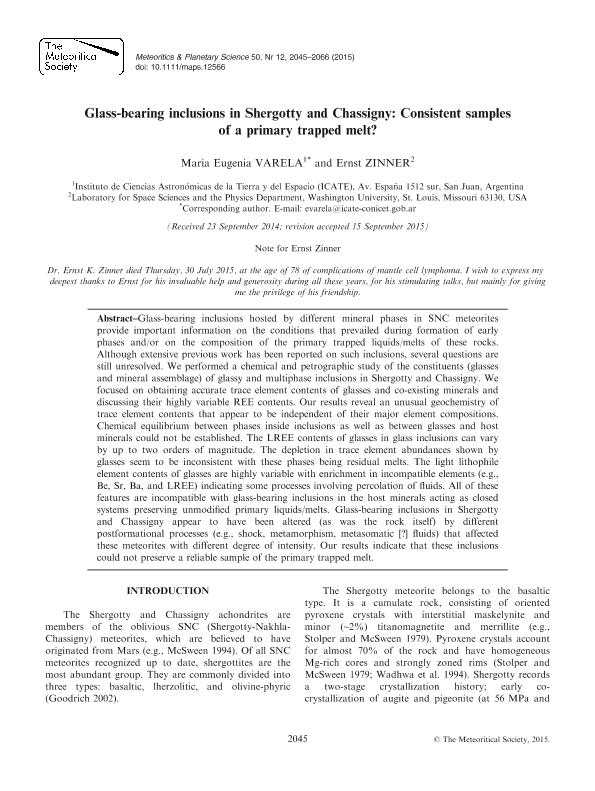Mostrar el registro sencillo del ítem
dc.contributor.author
Varela, Maria Eugenia

dc.contributor.author
Zinner, Ernst
dc.date.available
2016-03-21T20:45:39Z
dc.date.issued
2015-12
dc.identifier.citation
Varela, Maria Eugenia; Zinner, Ernst; Glass-bearing inclusions in Shergotty and Chassigny: Consistent samples of a primary trapped melt?; Wiley; Meteoritics & Planetary Science; 50; 12; 12-2015; 2045-2066
dc.identifier.issn
1086-9379
dc.identifier.uri
http://hdl.handle.net/11336/4893
dc.description.abstract
Glass-bearing inclusions hosted by different mineral phases in SNC meteorites provide important information on the conditions that prevailed during formation of early phases and/or on the composition of the primary trapped liquids/melts of these rocks.Although extensive previous work has been reported on such inclusions, several questions are still unresolved. We performed a chemical and petrographic study of the constituents (glasses and mineral assemblage) of glassy and multiphase inclusions in Shergotty and Chassigny. We focused on obtaining accurate trace element contents of glasses and co-existing minerals and discussing their highly variable REE contents. Our results reveal an unusual geochemistry of trace element contents that appear to be independent of their major element compositions. Chemical equilibrium between phases inside inclusions as well as between glasses and host minerals could not be established. The LREE contents of glasses in glass inclusions can vary by up to two orders of magnitude. The depletion in trace element abundances shown by glasses seem to be inconsistent with these phases being residual melts. The light lithophile element contents of glasses are highly variable withenrichment in incompatible elements (e.g., Be, Sr, Ba, and LREE) indicating some processesinvolving percolation of fluids. All of these features are incompatible with glass-bearing inclusions in the host minerals acting as closed systems preserving unmodified primary liquids/melts. Glass-bearing inclusions in Shergotty and Chassigny appear to have been altered (as was the rock itself) by different post formational processes [e.g., shock,metamorphism, metasomatic (?) fluids] that affected these meteorites with different degree of intensity. Our results indicate that these inclusions could not preserve a reliable sample of the primary trapped melt.
dc.format
application/pdf
dc.language.iso
eng
dc.publisher
Wiley

dc.rights
info:eu-repo/semantics/openAccess
dc.rights.uri
https://creativecommons.org/licenses/by-nc-sa/2.5/ar/
dc.subject
Glass Inclusions
dc.subject
Snc Meteorites
dc.subject
Shergotty
dc.subject
Chassigny
dc.subject.classification
Física Atómica, Molecular y Química

dc.subject.classification
Ciencias Físicas

dc.subject.classification
CIENCIAS NATURALES Y EXACTAS

dc.title
Glass-bearing inclusions in Shergotty and Chassigny: Consistent samples of a primary trapped melt?
dc.type
info:eu-repo/semantics/article
dc.type
info:ar-repo/semantics/artículo
dc.type
info:eu-repo/semantics/publishedVersion
dc.date.updated
2016-03-30 10:35:44.97925-03
dc.journal.volume
50
dc.journal.number
12
dc.journal.pagination
2045-2066
dc.journal.pais
Estados Unidos

dc.journal.ciudad
Hoboken
dc.description.fil
Fil: Varela, Maria Eugenia. Consejo Nacional de Investigaciones CientiÂficas y Tecnicas. Centro Cientifico Tecnologico San Juan. Instituto de Ciencias Astronomicas de la Tierra y del Espacio; Argentina
dc.description.fil
Fil: Zinner, Ernst. Washington University. Laboratory for Space Sciences and the Physics Department; Estados Unidos
dc.journal.title
Meteoritics & Planetary Science

dc.relation.alternativeid
info:eu-repo/semantics/altIdentifier/url/http://onlinelibrary.wiley.com/doi/10.1111/maps.12566/abstract
dc.relation.alternativeid
info:eu-repo/semantics/altIdentifier/doi/http://dx.doi.org/10.1111/maps.12566
dc.relation.alternativeid
info:eu-repo/semantics/altIdentifier/doi/10.1111/maps.12566
Archivos asociados
